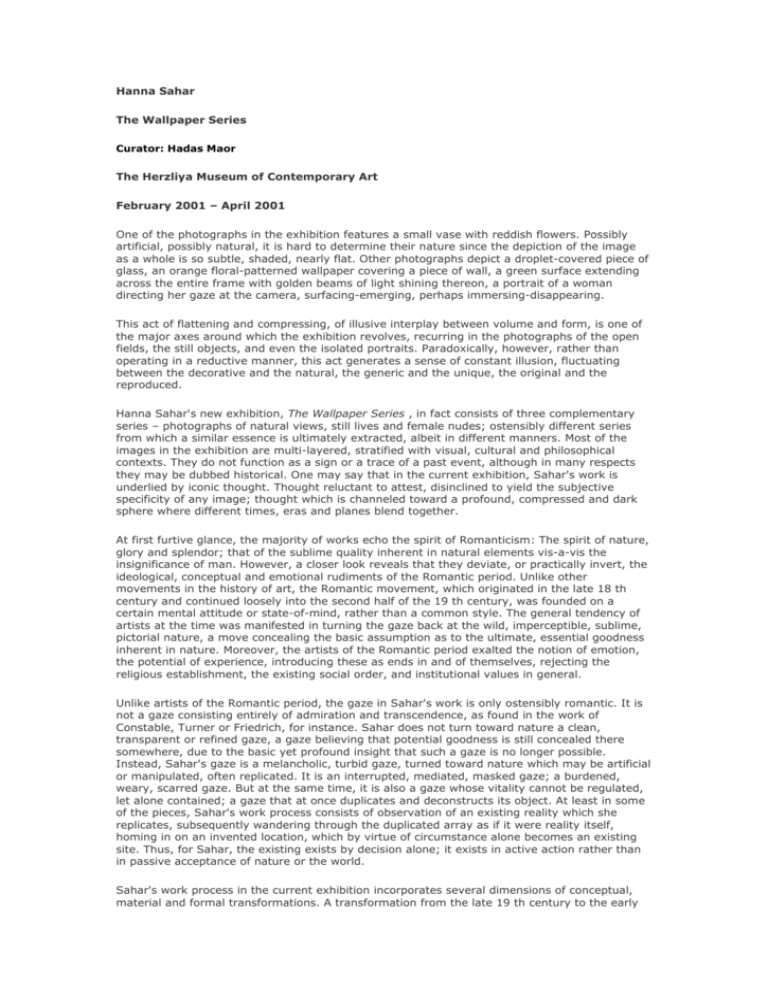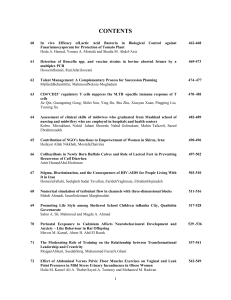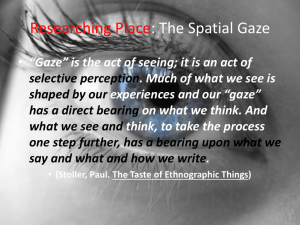Text - Hanna Sahar
advertisement

Hanna Sahar The Wallpaper Series Curator: Hadas Maor The Herzliya Museum of Contemporary Art February 2001 – April 2001 One of the photographs in the exhibition features a small vase with reddish flowers. Possibly artificial, possibly natural, it is hard to determine their nature since the depiction of the image as a whole is so subtle, shaded, nearly flat. Other photographs depict a droplet-covered piece of glass, an orange floral-patterned wallpaper covering a piece of wall, a green surface extending across the entire frame with golden beams of light shining thereon, a portrait of a woman directing her gaze at the camera, surfacing-emerging, perhaps immersing-disappearing. This act of flattening and compressing, of illusive interplay between volume and form, is one of the major axes around which the exhibition revolves, recurring in the photographs of the open fields, the still objects, and even the isolated portraits. Paradoxically, however, rather than operating in a reductive manner, this act generates a sense of constant illusion, fluctuating between the decorative and the natural, the generic and the unique, the original and the reproduced. Hanna Sahar's new exhibition, The Wallpaper Series , in fact consists of three complementary series – photographs of natural views, still lives and female nudes; ostensibly different series from which a similar essence is ultimately extracted, albeit in different manners. Most of the images in the exhibition are multi-layered, stratified with visual, cultural and philosophical contexts. They do not function as a sign or a trace of a past event, although in many respects they may be dubbed historical. One may say that in the current exhibition, Sahar's work is underlied by iconic thought. Thought reluctant to attest, disinclined to yield the subjective specificity of any image; thought which is channeled toward a profound, compressed and dark sphere where different times, eras and planes blend together. At first furtive glance, the majority of works echo the spirit of Romanticism: The spirit of nature, glory and splendor; that of the sublime quality inherent in natural elements vis-a-vis the insignificance of man. However, a closer look reveals that they deviate, or practically invert, the ideological, conceptual and emotional rudiments of the Romantic period. Unlike other movements in the history of art, the Romantic movement, which originated in the late 18 th century and continued loosely into the second half of the 19 th century, was founded on a certain mental attitude or state-of-mind, rather than a common style. The general tendency of artists at the time was manifested in turning the gaze back at the wild, imperceptible, sublime, pictorial nature, a move concealing the basic assumption as to the ultimate, essential goodness inherent in nature. Moreover, the artists of the Romantic period exalted the notion of emotion, the potential of experience, introducing these as ends in and of themselves, rejecting the religious establishment, the existing social order, and institutional values in general. Unlike artists of the Romantic period, the gaze in Sahar's work is only ostensibly romantic. It is not a gaze consisting entirely of admiration and transcendence, as found in the work of Constable, Turner or Friedrich, for instance. Sahar does not turn toward nature a clean, transparent or refined gaze, a gaze believing that potential goodness is still concealed there somewhere, due to the basic yet profound insight that such a gaze is no longer possible. Instead, Sahar's gaze is a melancholic, turbid gaze, turned toward nature which may be artificial or manipulated, often replicated. It is an interrupted, mediated, masked gaze; a burdened, weary, scarred gaze. But at the same time, it is also a gaze whose vitality cannot be regulated, let alone contained; a gaze that at once duplicates and deconstructs its object. At least in some of the pieces, Sahar's work process consists of observation of an existing reality which she replicates, subsequently wandering through the duplicated array as if it were reality itself, homing in on an invented location, which by virtue of circumstance alone becomes an existing site. Thus, for Sahar, the existing exists by decision alone; it exists in active action rather than in passive acceptance of nature or the world. Sahar's work process in the current exhibition incorporates several dimensions of conceptual, material and formal transformations. A transformation from the late 19 th century to the early 21 st century, from painting to photography, from the organic to the mechanic, from canvas to paper. In the process, yet another transformation occurs, from the persistent attempt to capture a moment, a fragment of an existing, vital, vivid reality – of what comes under the notion of Tableau Vivant – to the ability to disintegrate the given moment into its components, into the reverberation of death as evolving from the notion of Tableau Mort . To wit, a transition from the medium of painting which strives to capture the very spirit of life to the medium of photography which, in its very essence, bears the message of death (“…which produces Death while trying to preserve life.” Roland Barthes, Camera Lucida ). Thus, the tableaux of death arrayed in Sahar's exhibition capture fragments of reality, fixating them, not in order to perpetuate them in all their vitality, but rather in an attempt to extract and refine therefrom the a-temporal essence of their being. Alongside the photographs of nature and still life, the exhibition features portrait and female nude photographs. The nudity in these photographs is not contemporary, private, harsh or exposing. Indeed it is nudity rather than nakedness, namely nude in keeping with the Classicist tradition, addressing questions of contour, matter and gaze, rather than issues of presence, identity and gender. Thus, for example, a photograph portraying a nude woman, sittingreclining on an unmade bed, alludes to Jean-Auguste Dominique Ingres' Odalisque , 1814, and a photograph depicting a female figure sitting-stooping with her back to the camera, brings to mind Edgar Degas' painting, The Tub , 1886. Still and all, a closer look reveals that a single figure recurs in all the portrait and nude photographs. An enigmatic figure of a young woman, who rather then being characterized in her own right, functions as a vehicle for forming the gaze photographing her. A gaze of one woman at another. A gaze which constitutes yet another layer in the sequence of transformations generated by Sahar in the course of her work. Sahar's oeuvre constitutes a dialectic of time and space, and mainly, of her chosen medium of operation. At the beginning of the third millenium, in view of the constantly changing, everevolving technologies, Sahar chooses to cling to the medium of photography as an intricate language of expression and creation, rather than as a mere technical means. 19 th century philosophers, such as Wilhelm von Humboldt (1767-1835), believed that language embodies our perception of the world and determines the very way in which we think and perceive the world around us. In other words, language enforces itself on reality, structures affinities with it, and forms our perception of it. (a doctrine dubbed “linguistic determinism”, which Humboldt was one of the first to describe). Similarly, Sahar enforces her own perception on the visual reality to which she is exposed. Remaining within the confines of the language of direct photography, and without relying on digital technologies, she stretches the opticalchemical capacities of the medium to the limit. She chooses existing sites, unpretentious landscapes, unprivileged fragments, turning her gaze towards them, pausing, immersing herself entirely within them, thus rendering them exclusive to her. In fact, one may say she constitutes an experience, explores the range of possibilities for creating a sensation. Thus, the tension between the conceptual and the spiritual in Sahar's work transpires on a fine line; a vanishing, nearly extinguished threshold point. Indeed, it may be said that her gaze aspires to the aesthetic, the beautiful, perhaps to the sublime. But reaching it, touching lightly, it flows beyond it, immersing in its excessive dimension, gaping a hole in the very essence of its sublimity, creating an intricate situation, where moments of aesthetic purity are constituted and crushed at one and the same time.





